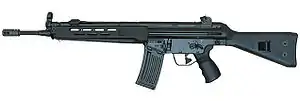Heckler & Koch HK43
The Heckler and Koch HK43 is a semi-automatic rifle based upon the Heckler & Koch HK33 rifle and is the predecessor of the Heckler & Koch HK93 semi-automatic rifle.
| Heckler & Koch HK43 | |
|---|---|
 HK43A2 | |
| Type | Semi-automatic rifle |
| Place of origin | West Germany |
| Production history | |
| Manufacturer | Heckler & Koch |
| Produced | March 1974 - 1989 |
| Variants | KA1, A2 and A3 |
| Specifications | |
| Mass | 8.4 pounds (3.8 kg) (empty magazine) |
| Length | 36.2 inches (920 mm) |
| Barrel length | 16.975 inches (431.165 mm) |
| Cartridge | 5.56×45mm NATO, .223 Remington |
| Action | Roller-delayed blowback |
| Rate of fire | Semi-automatic |
| Feed system | 5, 20, 25, 30 or 40-round double column, detachable box magazine |
| Sights | Protected post front, rotating diopter rear sight |
Overview
In the mid to late 1960s, Heckler & Koch developed the HK33, which was a scaled-down version of the Heckler & Koch G3, but chambered for 5.56×45mm NATO. The HK33 entered production in 1968. In 1974, a semi-automatic version of the HK33 was introduced by H&K and was designated the HK43. According to H&K’s numbering nomenclature, the “4” indicates that the weapon is a paramilitary rifle, and the “3” indicates that the caliber is 5.56 mm.
HK43 can sell for anywhere between $4,500 and $9,000 depending on the condition and the economy at the time.
A HK43 version KA1 with a shorter 322 mm barrel was used in 1977 by the German RAF terrorist group to assassinate general attorney Siegfried Buback and two policemen.[1][2] Verena Becker, another former RAF member, has also claimed Wisniewski was the killer.[2]